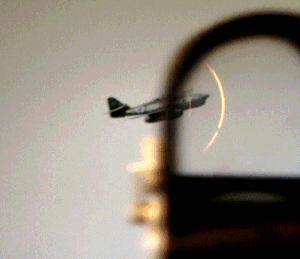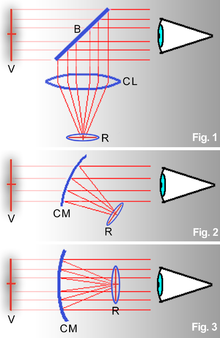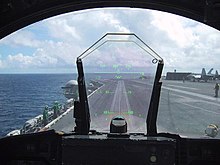
Parallax is a displacement or difference in the apparent position of an object viewed along two different lines of sight and is measured by the angle or half-angle of inclination between those two lines. Due to foreshortening, nearby objects show a larger parallax than farther objects, so parallax can be used to determine distances.
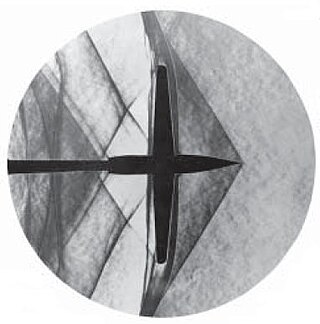
Schlieren photography is a process for photographing fluid flow. Invented by the German physicist August Toepler in 1864 to study supersonic motion, it is widely used in aeronautical engineering to photograph the flow of air around objects.

A collimated beam of light or other electromagnetic radiation has parallel rays, and therefore will spread minimally as it propagates. A perfectly collimated light beam, with no divergence, would not disperse with distance. However, diffraction prevents the creation of any such beam.

The Advanced Combat Optical Gunsight (ACOG) is a series of prismatic telescopic sights manufactured by Trijicon. The ACOG was originally designed to be used on the M16 rifle and M4 carbine, but Trijicon has also developed ACOG accessories for other firearms. Models provide fixed-power magnification levels from 1.25× to 6×. ACOG reticles are illuminated at night by an internal tritium phosphor. Some versions have an additional daytime reticle illumination via a passive external fiberoptic light pipe or are LED-illuminated using a dry battery. The first ACOG model, known as the TA01, was released in 1987.

A reticle, or reticule also known as a graticule, is a pattern of fine lines or markings built into the eyepiece of an optical device such as a telescopic sight, spotting scope, theodolite, optical microscope or the screen of an oscilloscope, to provide measurement references during visual inspections. Today, engraved lines or embedded fibers may be replaced by a digital image superimposed on a screen or eyepiece. Both terms may be used to describe any set of patterns used for aiding visual measurements and calibrations, but in modern use reticle is most commonly used for weapon sights, while graticule is more widely used for non-weapon measuring instruments such as oscilloscope display, astronomic telescopes, microscopes and slides, surveying instruments and other similar devices.
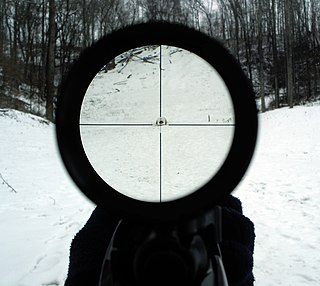
A telescopic sight, commonly called a scope informally, is an optical sighting device based on a refracting telescope. It is equipped with some form of a referencing pattern – known as a reticle – mounted in a focally appropriate position in its optical system to provide an accurate point of aim. Telescopic sights are used with all types of systems that require magnification in addition to reliable visual aiming, as opposed to non-magnifying iron sights, reflector (reflex) sights, holographic sights or laser sights, and are most commonly found on long-barrel firearms, particularly rifles, usually via a scope mount. Similar devices are also found on other platforms such as Artillery, Tanks and even Aircraft. The optical components may be combined with optoelectronics to add night vision or smart device features.
A collimator is a device which narrows a beam of particles or waves. To narrow can mean either to cause the directions of motion to become more aligned in a specific direction, or to cause the spatial cross section of the beam to become smaller.

The Sight Unit Small Arms, Trilux, or SUSAT, is a 4× telescopic sight, with tritium-powered illumination utilised at dusk or dawn. The full name of the current model is the SUSAT L9A1. The sight is not designed as a sniper sight, but is rather intended to be mounted on a variety of rifles and to be used by all infantrymen. A similar device is the Advanced Combat Optical Gunsight (ACOG).

A sight or sighting device is any device used to assist in precise visual alignment of ranged weapons, surveying instruments, aircraft equipment or optical illumination equipments with the intended target. Sights can be a simple set or system of physical markers that serve as visual references for directly aligning the user's line of sight with the target, or optical instruments that provide an optically enhanced — often magnified — target image aligned in the same focus with an aiming point. There are also sights that actively project an illuminated point of aim onto the target itself so it can be observed by anyone with a direct view, such as laser sights and infrared illuminators on some night vision devices, as well as augmented or even virtual reality-enabled digital cameras with software algorithms that produce digitally enhanced target images.

Boresighting is a method of visually pre-aligning a firearm barrel's bore axis with the target, in order to more easily zero the gunsight. The process is usually performed on a rifle, and can be accomplished either with the naked eye, or with a specialized device called a boresighter.
Aimpoint AB is a Swedish optics company based in Malmö, Sweden that manufactures red dot sights.

A finderscope is an accessory sighting device used in astronomy and stargazing, typically a small auxiliary refracting telescope/monocular mounted parallelly on a larger astronomical telescope along the same line of sight. The finderscope usually has a much smaller magnification than the main telescope, thus providing a larger field of view, useful for manually pointing the main telescope into a roughly correct direction that can easily place a desired astronomical object in view when zooming in. Some finderscopes have sophisticated reticles to more accurately aim the main telescope and/or even perform stadiometric measurements.
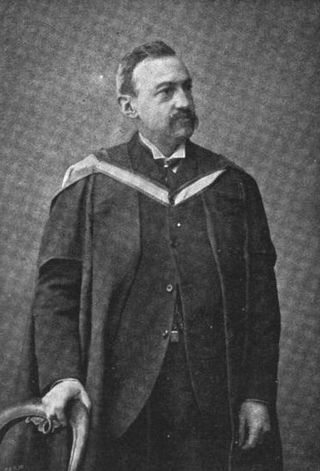
Sir Howard Grubb was an optical designer from Dublin, Ireland. He was head of a family firm that made large optical telescopes, telescope drive controls, and other optical instruments. He is also noted for his work to perfect the periscope and inventing the reflector sight.

A red dot sight is a common classification for a non-magnifying reflector sight that provides an illuminated red dot to the user as a point of aim. A standard design uses a red light-emitting diode (LED) at the focus of collimating optics, which generates a dot-style illuminated reticle that stays in alignment with the weapon the sight is attached to, regardless of eye position.

A holographic weapon sight or holographic diffraction sight is a non-magnifying gunsight that allows the user to look through a glass optical window and see a holographic reticle image superimposed at a distance on the field of view. The hologram of the reticle is built into the window and is illuminated by a laser diode.

A collimator sight is a type of optical sight that allows the user looking into it to see an illuminated aiming point aligned with the device the sight is attached to, regardless of eye position. They are also referred to as collimating sights or "occluded eye gunsight" (OEG).

A sight magnifier is an optical telescope that can be paired with a non-magnifying optical sight on a weapon to create a telescopic sight. They work with the parallel collimated reticle image produced by red dot sights and holographic weapon sights. They may synonymously be referred to as a red dot magnifier, reflex sight magnifier, holographic sight magnifier, or flip to side magnifiers.

A prism sight or prismatic sight, sometimes also called prism scope or prismatic scope, is a type telescopic sight which uses a reflective prism for its image-erecting system, instead of the series of relay lenses found in traditional telescopic sights. The use of prisms makes it possible to construct a shorter and lighter sight, or with an offset between the eyepiece and objective axes.
